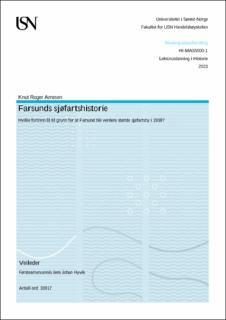| dc.contributor.advisor | Hyvik, Jens Johan | |
| dc.contributor.author | Arnesen, Knut Roger | |
| dc.date.accessioned | 2023-06-24T16:41:42Z | |
| dc.date.available | 2023-06-24T16:41:42Z | |
| dc.date.issued | 2023 | |
| dc.identifier | no.usn:wiseflow:6825505:54274285 | |
| dc.identifier.uri | https://hdl.handle.net/11250/3073043 | |
| dc.description.abstract | Denne mastergradsavhandlingen undersøker hvilke fortrinn Farsunds sjøfartsnæring besatt i perioden mellom 1880 og 1938, som resulterte i en kraftig utvikling i byens maritime næring. I løpet av denne perioden gikk Farsund fra å være en relativt liten uthavn langs sørlandskysten av Norge, til å bli en av landets største sjøfartsbyer i totale tall, og verdens største sjøfartsby i forhold til tonnasje pr. innbygger. De sentrale rederiene; Brøvig, Mosvold, Lundegaard & Stray, Samuelsen & Olsen og Salvesen blir presentert og anvendt for å gi spesifikke eksempler på datidens trender og hendelser.
Oppgaven benytter et teoretisk rammeverk for å diskutere den lokale sjøfartsnæringens utvikling i perioden. Michael E. Porters teorier om konkurranse og næringsklynge anvendes på næringer innen et geografisk avgrenset område for å kartlegge næringsklyngens faktorer for suksess. Konkurranseteorien hans vektlegger aktørenes konkurransestrategi for drift i markedet. Teorien om næringsklynger plasseres i Porters diamantmodell der faktorene; faktorforhold, etterspørselsforhold, konkurranseforhold og klyngeforhold blir undersøkt og diskutert med formålet om å kartlegge hvilke faktorer klyngens aktører drar nytte av fra å være en del av næringsklyngen. Sentrale elementer gjennom denne avhandlingen er å diskutere og kartlegge hvilke fortrinn Farsunds sjøfartsnæring besatt, som skilte byen fra den øvrige regionale og nasjonale sjøfartsutviklingen.
Avhandlingen konkluderer med at det hovedsakelig var tre fortrinn som lå til grunn for utviklingen Farsunds sjøfartsnæring opplevde i perioden frem mot 1938. Det første er den geografiske beliggenheten på Norges sørlandskyst, sentralt på en av Europas viktigste handelsruter, mellom Østersjøen og Nordsjøen. Den tidlige avskjeden med lokalt konstruerte treskip allerede i 1857 gjorde sjøfartsnæringen mindre avhengig av lokale hensyn med tanke på lokal sysselsetting, det la til rette for at rederiene kunne gå til anskaffelse av rimelig second-hand tonnasje. Og kanskje det viktigste fortrinnet var den lokale sjøfartskulturen i Farsund. Hele byen var konstruert for og rundt sjøfart, rederne var overrepresentert blant lokale myndigheter i mangelen på konkurrerende sosial elite, og fra den posisjonen maktet de å styre lokalsamfunnet via formannskap, bankeierskap og sosial makt til å gi dem best mulig utgangspunkt til suksess i næringen. | |
| dc.description.abstract | This master’s thesis examines which advantages Farsund’s shipping industry possessed in the period between 1880 and 1938, which resulted in a major development within the city’s maritime industries. During this period, Farsund went from being a relatively small port along the southern coast of Norway, to becoming one of the country’s largest cities within maritime business in terms of total tonnage, and the world’s largest maritime city in terms of tonnage per inhabitant. Farsund’s leading shipping companies; Brøvig, Mosvold, Lundegaard & Stray, Samuelsen & Olsen and Salvesen are presented and used to provide specific examples of trends and events of the time.
The theoretical approach used throughout the thesis to discuss the development of the local shipping industry, stems from Michael E. Porter’s theories on competitive strategy and national advantages. Porter’s theories apply to industries within a geographically defined area and is used to map the industry cluster’s factors for success. The theory of competitive strategy emphasizes the company’s competitive strategy for operating in a global marked and the theory of national advantages is placed within Porter’s model The Determinants of National Advantages, which contains four factors; Factor conditions, Demand conditions, Related and supporting industries and Firm strategy, structure, and rivalry. The factors help to map the advantages the companies have from existing in an industry cluster. The central elements throughout this thesis are to discuss and map which advantages Farsund’s maritime industry possessed, and how they contributed to the development of the city’s maritime industry.
The thesis concludes that there were three main advantages which underlays Farsund’s shipping industry’s development in the period leading up to 1938. The first advantage is Farsund’s geographical location on Norway’s southern coast, centrally on one of Europe’s most important trade routes between the Baltic Sea and the North Sea. Secondly, the early dismissal of locally constructed wooden ships in 1857 made the local shipping industry less dependent on local considerations in terms of local employment, which again led to it being more attainable to acquire affordable second-hand tonnage. Thirdly, and perhaps the most important advantage, was the local maritime culture within Farsund. The entire city was constructed for and around shipping. The shipowners were highly represented among local authorities in lack of other social elite-groups. From their positions in power, they were able to manage the local community through chairmanship, bank ownership and social power. All to give the shipping industry the best possible starting point for success | |
| dc.language | nob | |
| dc.publisher | University of South-Eastern Norway | |
| dc.title | Farsunds Sjøfartshistorie | |
| dc.type | Master thesis | |
